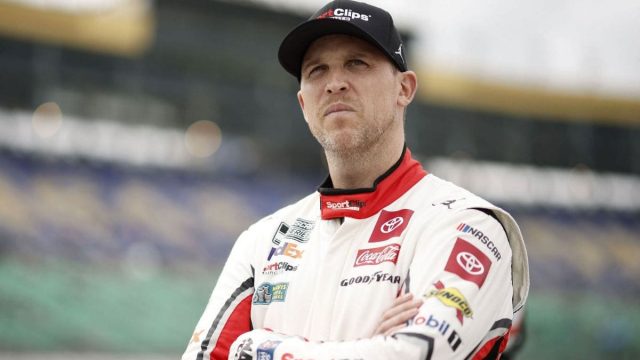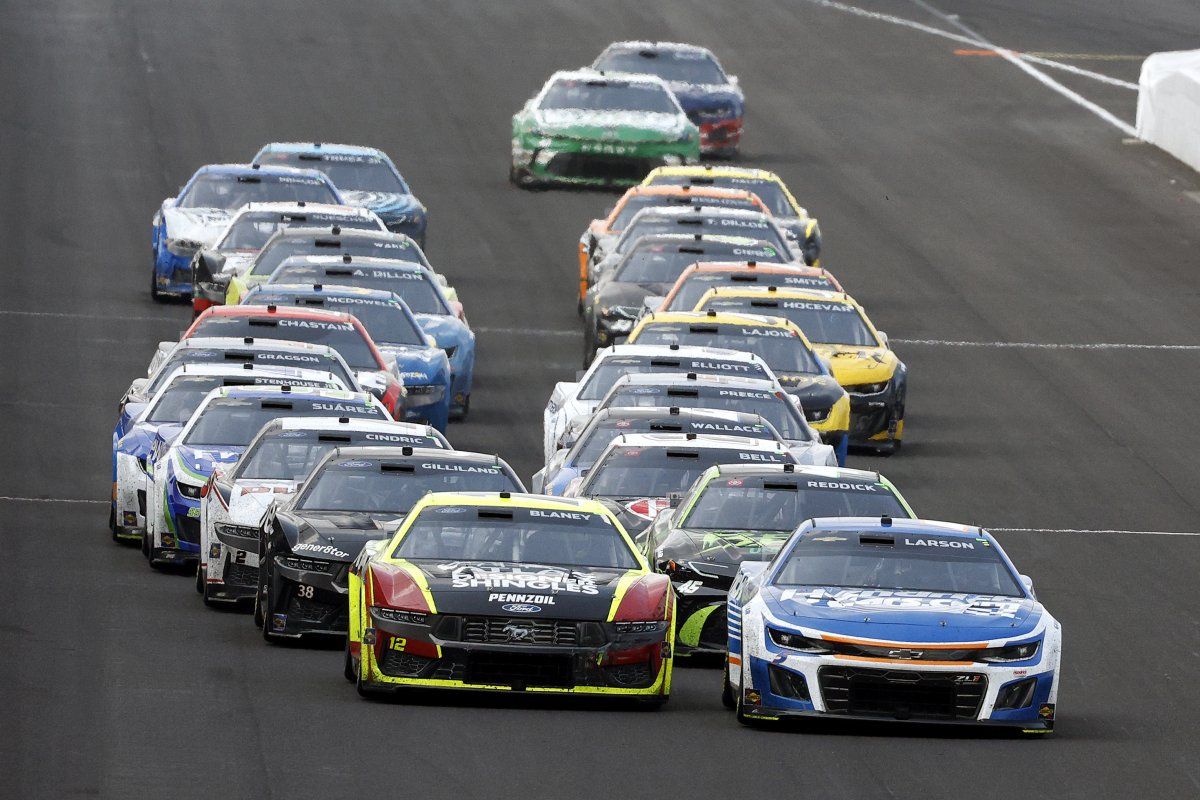Denny Hamlin’s 18 Million Dollar Charter Debate: Denny Hamlin‘s recent argument regarding the $18 million budget allocation for NASCAR charters highlights a critical examination of the financial landscape within the sport. His assertion that this figure is insufficient for competitive viability not only clarifies the disparities in team funding but also raises pertinent questions about the efficacy of current revenue distribution models. As Hamlin advocates for a more equitable structure, the dialogue surrounding sponsorship revenue and operational costs becomes increasingly complex, hinting at deeper systemic issues that could redefine the competitive balance in NASCAR. What implications might this have for the future of the sport?
Key Highlights
- Denny Hamlin advocates for equitable revenue distribution to address the financial disparities among NASCAR teams, emphasizing the need for permanent charters.
- Hamlin argues that the current operational costs of $18 million per week are insufficient for competitive success in NASCAR.
- The debate reflects a broader concern regarding NASCAR’s revenue distribution and its impact on team competitiveness, particularly for lower-funded teams.
- Fiscal conservatism, as advocated by driver Cassill, contrasts with Hamlin’s view that significant investment is necessary to remain competitive.
NASCAR’s Sponsorship Revenue and Teams’ Financial Struggles
NASCAR’s intricate financial landscape is highlighted by a pronounced disparity between the lucrative sponsorship revenues generated by top-tier teams and the persistent financial struggles faced by many within the sport, emphasizing the inherent disparities in competitive viability and operational sustainability.
Leading organizations like Team Penske have showed the financial potential of success in NASCAR, with their reported sponsorship revenue reaching an impressive US$140.94 million, largely propelled by Ryan Blaney’s Championship victory. This striking revenue contrast raises critical questions regarding the economic framework that governs the sport.
While elite teams flourish financially, lesser-funded teams often grapple with limited sponsorship opportunities and insufficient resources to compete effectively. The disparity creates a tiered system where only a select few can consistently vie for victories, resulting in a competitive imbalance.
This phenomenon not only hampers the growth potential of struggling teams but also diminishes the overall appeal of NASCAR as a whole, as fans increasingly gravitate toward the more successful teams that dominate the narrative.
The financial gulf within NASCAR emphasizes the necessity for reformative strategies that improve revenue distribution and sponsorship accessibility across all teams.
Without addressing these disparities, the sport risks alienating a notable portion of its competitive field, thereby jeopardizing its long-term sustainability.
Denny Hamlin’s Argument on Team Costs and Revenue
Amidst the looming deadline of 2024, Denny Hamlin has emerged as a vocal advocate for race teams, emphasizing the urgent need for permanent charters and a more equitable distribution of the substantial revenue generated from NASCAR’s recent $7.7 billion media rights deal.
His argument is predicated on the escalating operational costs that teams face, which he estimates to be around $18 million merely to field a competitive vehicle each week. This figure highlights the financial burden placed on teams, particularly in an environment where revenue-sharing remains heavily skewed in favor of NASCAR.
Hamlin’s call for permanent charters reflects a desire for stability and predictability in a sport where financial viability can often be tenuous. The fear of losing charter status can lead to a cycle of spending that may not align with a team’s actual revenue potential. Such instability can deter investment in performance improvements and comprehensive competitiveness, impacting the sport’s integrity and growth.
Given the substantial media rights deal, Hamlin’s argument gains further weight. With NASCAR reaping considerable financial rewards, the expectation for a more generous distribution of funds to the teams becomes paramount. This equitable distribution could alleviate some of the economic strains teams face, allowing them to operate more sustainably.
Landon Cassill vs. Denny Hamlin on Team Spending
The ongoing debate between Landon Cassill and Denny Hamlin highlights a fundamental divide in perceptions of team spending within NASCAR, where the financial demands of competing at a high level sharply contrast with calls for budgetary restraint.
Cassill’s perspective emphasizes fiscal conservatism, arguing that excessive expenditures on peripheral elements can detract from the sport’s sustainability. He suggests that NASCAR possesses the capacity to demand more prudent financial practices from teams, which could lead to a more equitable distribution of resources.
“NASCAR has the most leverage…It’s difficult for the teams to go to NASCAR and ask for a whole lot more money when NASCAR can see that they are spending a lot of money on all these maybe unnecessary details. Broadly speaking, Landon Cassill’s point makes sense.” – Estepp
However, this viewpoint overlooks the reality of modern NASCAR competition, particularly when faced with formidable teams like Joe Gibbs Racing and Hendrick Motorsports. As noted by journalist Eric Estepp, the necessity of maintaining a competitive edge in such an environment often compels teams to invest considerably in the latest technology and resources.
“If you’re going to compete in a sport that Rick Hendrick, Roger Penske, and Joe Gibbs participate in, you better be willing to spend, spend, and spend just to remain remotely competitive. Sure, you could simply run a team on an $18 Million budget, but it won’t be a competitive team. You’ll run 25th to 30th.” – Estepp
Hamlin’s counterargument asserts that a budget of $18 million is insufficient for teams aspiring to be competitive, with the risk of consistently finishing in the lower tiers of the standings.
The crux of the debate lies in the balance between fiscal responsibility and the imperative to invest in performance. While Cassill’s cautionary stance is valid, it must be reconciled with the harsh realities of a sport where success is increasingly tied to financial commitment.
Denny Hamlin’s Detailed Explanation and NASCAR’s Revenue Transparency
Denny Hamlin frequently emphasizes the intricate financial dynamics that underpin the operation of a competitive NASCAR team, highlighting the necessity of diverse departments such as marketing, sponsorship, and social media in sustaining performance and profitability.
His recent discourse with Landon Cassill serves as an example of this complexity, where Hamlin provided a thorough breakdown of costs associated with running a race team like 23XI Racing. This detailed analysis not only highlights the multifaceted nature of team operations but also exposes the often-overlooked financial realities that non-participants may underestimate.
Moreover, the debate reveals a critical aspect of NASCAR’s revenue structure, particularly in consideration of the sport’s shift to a private entity in 2019. Historically, NASCAR maintained a level of financial transparency, with reports such as International Speedway Corporation’s $645 million revenue and Speedway Motorsports Inc.’s $502 million in 2010 providing stakeholders with insights into the economic landscape.
Hamlin’s advocacy for a larger share of revenue reflects a broader call for transparency within the sport. By dissecting the financial requirements necessary for competitive viability, he not only champions the interests of team owners but also initiates a dialogue on the need for greater clarity in NASCAR’s revenue-sharing frameworks.
NASCAR’s Cost-Cutting Measures and Pit Gun Controversy
Cost-cutting measures implemented by NASCAR have sparked considerable controversy, particularly regarding the introduction of spec pit guns, which have proven to compromise the reliability and effectiveness of pit stops during critical race moments. The decision to standardize equipment in an effort to level the playing field has led to unforeseen complications that impact race outcomes and driver performance.
The rationale behind the introduction of spec pit guns can be summarized in four key points:
- Cost Containment: NASCAR aimed to reduce expenses for teams by standardizing equipment, believing this would prevent wealthier teams from gaining disproportionate advantages.
- Competition Improvement: The intention was to equalize performance across the board, allowing less-funded teams to compete more effectively against industry giants.
- Increased Reliability: NASCAR’s hope was that a single design would yield more consistent performance, but the opposite has often been true, as evidenced by critical failures during races.
- Driver Frustration: High-profile drivers like Denny Hamlin have publicly criticized the reliability of these spec pit guns, insisting that teams previously developed superior, customized solutions that better suited their needs.
“I think the reason teams built them on their own is because they were more reliable that way. They could control everything. That’s probably why; amongst the competition side of things, they don’t want to fail because it’s a bad luck thing. They want it to fail because they did a bad job. It’s your own fault then.” – Hamlin
The fallout from this cost-cutting initiative has revealed that NASCAR’s approach may inadvertently hinder rather than help the sport’s competitive integrity. As teams struggle with unreliable tools, questions arise about NASCAR’s commitment to fostering an environment where talent can truly shine.
News in Brief: Denny Hamlin’s 18 Million Dollar Charter Debate
The debate surrounding Denny Hamlin’s $18 million charter budget highlights the pressing financial disparities within NASCAR.
The discussion reveals the importance of equitable revenue distribution and structural reforms to address the competitive imbalances faced by lower-funded teams.
As teams struggle with escalating costs, the call for greater transparency and effective cost management becomes increasingly critical.
Ultimately, addressing these financial inequities is vital for fostering a more competitive and sustainable environment within the sport.
ALSO READ: Denny Hamlin Responds Strongly to Landon Cassill’s NASCAR Cost Claims




Too much money involved in Nascar racing. Im going back to the good ole boys dirt tracks.